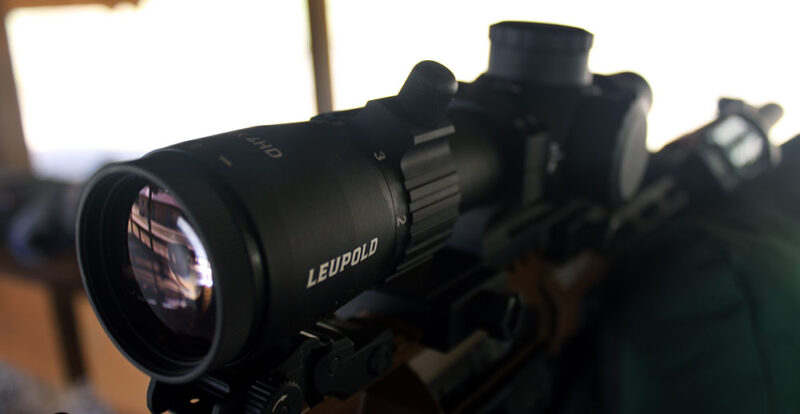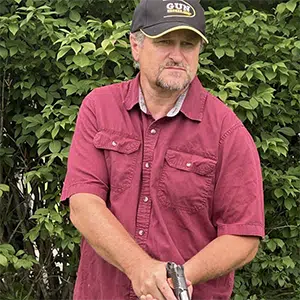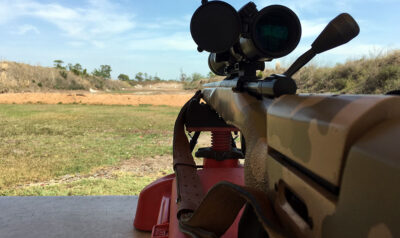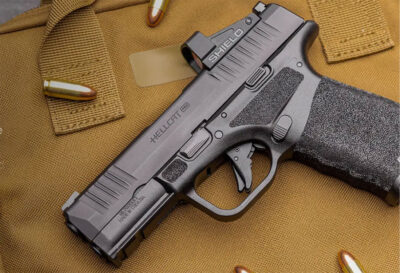Springfield SAINT Victor Rifle: Upgraded, Improved, Still Great

Some call it the Modern Sporting Rifle, others America’s rifle. Either way, Eugene Stoner’s AR-15 is one of the most popular firearms in the country. Most of it is because of the its modularity and functionality, but part of it just might be because of the Federal Assault Weapon’s ban of 1994. Americans just don’t like being told we can or can’t do or own.
Since the bill’s sunset in 2004, AR-stye rifles have exploded in popularity, with numerous companies competing in the marketplace. Today, shooters have a variety of options regarding ARs, from basic models to high-end versions with every desired feature. This includes numerous mid-level ARs with varying levels of features, such as the Springfield Armory SAINT Victor Rifle.
The SAINT Victor sits on the upper end of mid-level ARs—as an upgrade of the Springfield SAINT—with rifle, pistol and PCC models containing a variety of features shooters desire. Some of these include a M-Lok free-float handguard, flat trigger, flip-up sights and SA muzzle brake. The rifles even use a mid-length gas-impingement system, instead of a carbine length, resulting in milder recoil and a smoother shooting.
Since its introduction in 2019, the SAINT Victor line has provided shooters with upper-end features at a fairly good price point. These rifles don’t offer everything but they also don’t cost an exorbitant amount. However, none of this stopped Springfield from updating the SAINT Victor line.
The New Springfield SAINT Victor
When Springfield decided to update the SAINT Victor line, it got serious. The company improved the barrel, handguard, charging handle, sights, safety and more. Two of the more interesting changes include the charging handle and the safety.
The SAINT Victor line of firearms now come with a Radian Raptor LT charging handle. It is much easier to manipulate, especially with an attached scope. It is not just a little easier, it is a lot easier. The safety, on the other hand, is just a safety. That is unless it is ambidextrous with a short 45-degree throw. That safety is little thing that makes a huge difference.
Other new features include an enhanced handguard with a full Picatinny rail on top, nice for attaching both a riflescope and backup sight, 4150 CMV steel barrel with a proprietary midweight taper, QD steel end plate, 7075 T6 proper mil-spec buffer tube and lower profile flip-up sights. Springfield also claims that it has enhanced tolerance and fitting attention throughout the series, which includes AR-10 rifles and AR-15 pistols. The rifles are available in black and coyote brown in 5.56 and 7.62, and tungsten gray in 5.56. The AR-15 pistols currently only comes in black.
Springfield even created versions for the more-restrictive states, with 10-round magazine capacities, as well as California-compliant models that feature a fixed Magpul stock and a Strike Industries California-compliant pistol grip. So far, there hasn’t been any mention of other chamberings.
Range Time
While the flip-up sights were on and accurate for iron sights, I ended up putting a Leupold Mark 4HD 1-4.5×24 SFP Firedot BDC riflescope on the Springfield SAINT Victor. I also added a Leupold DeltaPoint Pro red dot with a 45-degree AR mount, as a backup sight, just because I could. It looked absolutely cool and provided a close-quarters optic for fast-action shooting, even if the Leupold Mark 4HD was set at full power.
After attaching the pair of optics and bore-sighting the scope, I set up at 25 yards with a rest to ensure hits on paper and moved to 100 yards. Since I wanted the SAINT Victor sighted at 150 yards using American Eagle 55-grain FMJ, I used a ballistic calculator to determine the point of impact needed to be .51 inches low at 100 yards. I set it at a half inch.
Once the rifle cooled, I fired five, three-shot groups at 100 yards using the American Eagle ammo. The groupings were quite decent, with the smallest measuring .89 inches and the largest 1.4 inches. All five averaged 1.13 inches. After letting it cool down again, I fired five, five-shot groups, which were quite similar, except for a few flyers. Those groups averaged 1.35 inches without the flyers that were probably user error. With the flyers, the five groups averaged 1.75 inches. I also fired some three-shot groups with Hornady Varmint Express 40-grain V-Max . Point of impact moved with the lighter bullets, but accuracy stayed on par.
From there, I set up targets at distances ranging from 20 to 100 yards and ran some drills, including transitioning from the Mark 4HD to the DeltaPoint Pro. The Springfield SAINT Victor was light, easy to use and plenty accurate against all targets, especially with the pair of Leupold optics. I really liked how the handguard felt during drills.
Some features that shined in this process included the charging handle and the 45-degree ambi safety. I never think about these items on a standard AR; I guess I’m just used to them. This is especially true with the ambidextrous safety. I’ve never had a problem with the standard safety; the new safety of the SAINT Victor is much better, as is the Radian Raptor-LT charging handle. The flared magwell was also nice but unnecessary. I could take it or leave it. It just a part that shows how Springfield tries to get it right.
“From their Radian Raptor LT charging handles to their 45-degree ambi safeties to their full 12 o’clock Picatinny upper rail and their midweight-taper 4150 CMV steel barrels, the SAINT Victor line of rifles and pistols makes for an excellent choice for the discerning AR enthusiast,” said Mike Humphries, Media Relations Manager.
Suddenly, I Could See

I like optics. In fact, I’m not a fan of iron sights on rifles. I don’t mind irons on handguns as much but I want power in front of my eye on rifles, at least most of them. A whole lot of this comes from the fact that I don’t have the best eyes; I want the help. However, having a powerful optic on a AR kind of eliminates its CQB capabilities. That’s the benefit of having the Leupold Mark 4HD and DeltaPoint Pro combo on the Springfield SAINT Victor. The downside was having to sight-in two optics; it wasn’t that difficult.
I sighted the Mark 4HD at .5-inch low at 100 yards and DeltaPoint Pro dead on at 25 yards. Both kept zero throughout testing, including hard-run drills. Having the DeltaPoint Pro attached at a 45-degree angle, allowed me to keep the Mark 4HD at 4.5 power without losing fast-action shot ability. It also provided a backup option that worked well within my abilities out to 100 yards. I put the rounds on target, just not in any great groupings.
While I didn’t spend lots of time running the Leupold optics through tests, I did move the dial a few times in different directions, kicking the point of aim by 2 inches and back again. I had no issues going back to zero. There were also zero issues with fogging or glare.
In fact, all together, the Leupold Mark 4HD and the DeltaPoint with the Springfield SAINT Victor make for a well-rounded modern sporting rifle.
By Paul Rackley, GunBroker Editor







![SHOT Show 2025 Day 3 with GunBroker [Video]](https://qacontent.gunbroker.com/wp-content/uploads/2025/01/SHOT-Day-3-400x267.png)
![What’s New for 2025 From Meprolight? [Video]](https://qacontent.gunbroker.com/wp-content/uploads/2025/02/meprolight-video-featured-400x267.jpg)
![Introducing the Meprolight MVO Rifle Optics (Magnified Optics) | New for 2025 [Video]](https://qacontent.gunbroker.com/wp-content/uploads/2025/02/Mepro-MVO-rifle-optics_1-400x267.jpg)
![The New Tikka ACE Rifles [Video]](https://qacontent.gunbroker.com/wp-content/uploads/2025/02/Tikka-Featured-SHOT-2025-400x267.png)
![SNT Motiv K2S Semi-Auto Rifle Set for U.S. Release in 2025 [Video]](https://qacontent.gunbroker.com/wp-content/uploads/2025/04/SNT_Motiv_K2S-7-1200-x-800-400x267.jpg)